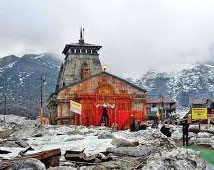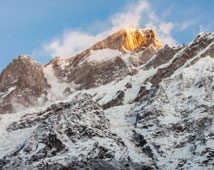
Amidst the dramatic mountainscapes of the majestic Kedarnath range stands one of the twelve 'Jyotirlingas' of Kedar or Lord Shiva. Lying at an altitude of 3584 mts. on the head of river Mandakini, the shrine of Kedarnath is amongst the holiest pilgrimages for the Hindus.
Kedarnath is a majestic sight, standing in the middle of a wide plateau surrounded by lofty snow covered peaks. The present temple, built in the 8th century by Adi Shankaracharya, stands adjacent to the site of an earlier temple built by the Pandavas. The inner walls of the assembly hall are decorated with figures of various deities and scenes from mythology. Outside the temple door a large statue of the Nandi Bull stands as guard.
Dedicated to Lord Shiva, the exquisitely architectured Kedarnath temple is said to be more than a 1000 years old. Built of extremely large, heavy and evenly cut gray slabs of stones, it evokes wonder as to how these heavy slabs were handled in the earlier days. The temple has a " Garbha Griha" for worship and a Mandap apt for assemblies of pilgrims and visitors. A conical rock formation inside the temple is worshipped as Lord Shiva in his Sadashiva form.
Kedarnath is situated in the Uttar Kashi district of the northern state of Uttaranchal. Very close to the Indo-Chinese border, it is the source of the Mandakini River. It is couched in the scenic locales of the Garhwal Himalayas at 3583 meters above sea level. It is very cold in the winters with the ground being covered with snow. In the summers, the mercury barely crosses the 20°C mark. The place experiences about 150 cm of rainfall during the monsoons and so the best time to visit is between May and October. Kedarnath is near to Rishikesh (234 km) and Dehradun (250 km).

According to legend, Lord Shiva wished to elude the Pandavas, who had come to seek penitence for having killed their kin in the battle of Kurukshetra. He took refuge in Kedarnath in the form of a bull. Bhima, one of the Pandava brothers, found Shiva amongst a herd of cattle. Having identified the meanest and most arrogant of the herd as Shiva, Bhima is said to have grabbed him by the hindquarters. What remains at the shrine in Kedarnath is the rear end of the bull, with the rest of its body scattered throughout the Garhwal. Shiva dived into the ground leaving behind him a hump on the surface. This conical protrusion is worshipped as the idol. It is the main site of the Panch Kedar temples.
- Madhyamaheshwar
- Tunganath
- Kalpeshwar
- Rudranath
Three of these (barring Kalpeshwar) are in mountain meadows at higher altitudes than Kedarnath. The climb to Rudranath is the most strenuous though worth the trouble, as this meadow is one of the finest in Garhwal.